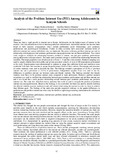| dc.contributor.author | Micheni, E. M. | |
| dc.contributor.author | Muketha, Geoffrey M. | |
| dc.date.accessioned | 2019-11-04T07:31:52Z | |
| dc.date.available | 2019-11-04T07:31:52Z | |
| dc.date.issued | 2019-10 | |
| dc.identifier.citation | Journal of Information Engineering and Applications, Vol.9, No.6, 2019 | en_US |
| dc.identifier.issn | 2224-5782 | |
| dc.identifier.uri | https://iiste.org/Journals/index.php/JIEA/article/view/49850/51512 | |
| dc.identifier.uri | http://hdl.handle.net/123456789/4362 | |
| dc.description.abstract | There has been a rapid growth in internet use in Kenya. Adolescents are the highest users of internet in the country. This puts adolescents at risk of becoming addictive internet users. Adolescent internet use has also been found to have negative consequences which include problematic social relationships, poor academic performance and psychological disturbance. Studies in other countries have associated increased levels of addictive internet use among individuals who are depressed. However, in Kenya, problem internet use and its relationship with depression and academic performance among adolescents has not been established. The current study sought to establish the relationship between problem of internet use and poor academic performance among adolescents in Kenya schools. The study used correlation design to establish the relationship between the variables. The target population was all adolescents in Form 1 - 4 and their class teachers. Random sampling was used to sample students from both public and private secondary schools. A total of 100 respondents participated in the study. Questionnaires were administered to students to gauge their addiction levels and interviews were conducted with their class teachers to gauge the performance levels of their students. Percentages and measures of central tendency were used to describe the data. The findings revealed a prevalence of 16.8% of problem internet use and a prevalence of 23.6% of performance. Independent samples T-test was used to test for differences in problem internet use between male and female students. The findings revealed that female students were likely to be problem internet users compared to male adolescents. Pearson’s product moment correlation was used to establish the relationship between poor academic performance and problem internet use and it was found that a weak positive relationship existed between poor academic performance and problem internet use. The study also identified various measures that could be used to mitigate the problem of problem internet use among adolescents. Based on the findings, it was concluded that there was need to identify and help the affected students exercise moderation and self control when using the internet in order for them to achieve their lifetime goals. The findings of the study also provide empirical evidence on the gender differences in performance and problem internet use which may be useful in improving counseling interventions for adolescent students/pupils. | en_US |
| dc.language.iso | en | en_US |
| dc.publisher | IISTE | en_US |
| dc.subject | poor academic performance | en_US |
| dc.subject | internet user | en_US |
| dc.subject | problem internet use | en_US |
| dc.subject | adolescents. | en_US |
| dc.title | Analysis of the Problem Internet Use (PIU) Among Adolescents in Kenyan Schools | en_US |
| dc.type | Article | en_US |

